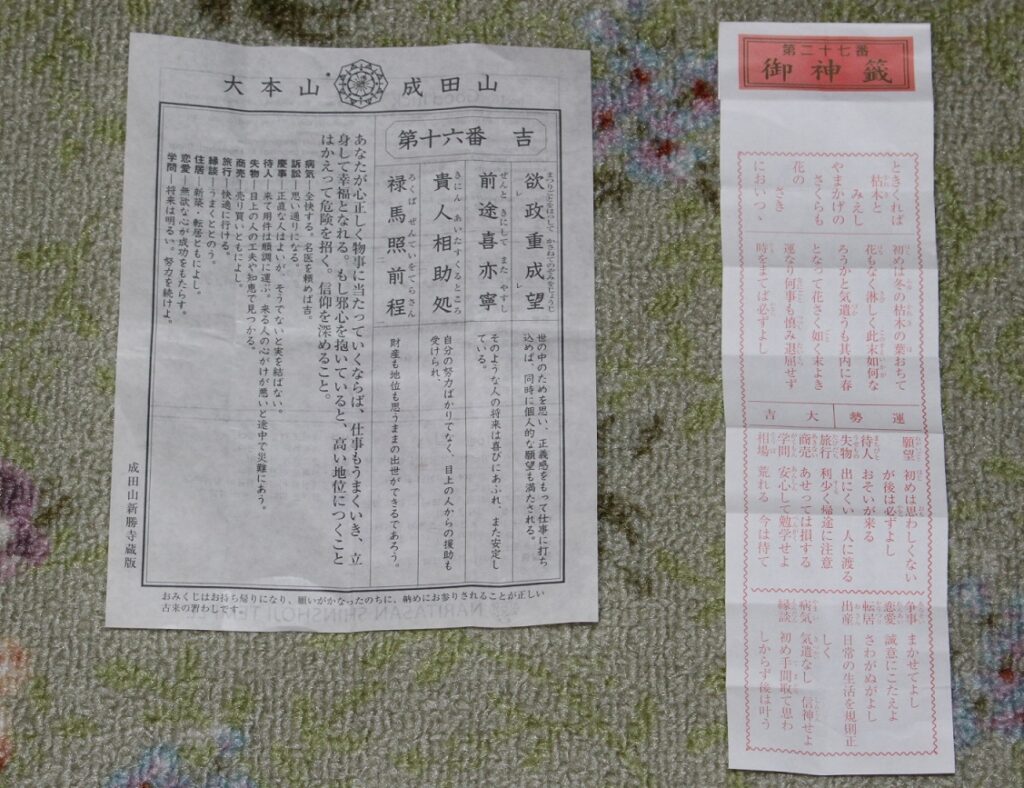When you visit a shrine or a temple in Japan, you probably find Lucky Charm (Omamori) and Paper Fortune (Omikuji). They are small items sold for 100 yen or so. It is usual for Japanese to buy them when visiting a Shinto shrine or a Buddhist temple.
1. Lucky Charm (Omamori)

Lucky charms (Omamori) are Japanese charms commonly sold at religious sites and dedicated to particular Shinto deities as well as Buddhist figures. They may serve to provide various forms of luck or protection.
The word Omamori means protection. Originally made from paper or wood, modern Omamori are small items kept inside a brocade bag and may contain a prayer, religious inscription of invocation. Usually the name of the shrine or the temple is written on the front side of the bag, and benefit is written on the back side.
While omamori are intended for visitors’ personal use, they are mainly viewed as a donation to the temple or the shrine. Visitors often give omamori to another person as a physical form of well-wishing.
Omamori may provide general blessings and protection, or may have a specific focus such as:
1) kōtsū-anzen : traffic safety.
2) yaku-yoke : avoidance of evil
3) kaiun : open luck, better fortune
4) gakugyō-jōju : education and passing examinations
5) shōbai-hanjō : success in business
6) en-musubi : finding a partner and marriage
7) Anzan : protection for pregnant women
8) kanai-anzen : safety (well-being) of one’s family
Customarily, omamori should never be opened in order to avoid losing their protective benefits, and should be carried on one’s person, or tied to a backpack, purse, etc.
2. Paper Fortune (Omikuji)

Paper fortune (Omikuji) are Japanese fortune-telling paper strips. Literally “sacred lot”, it is usually received by making a small offering and randomly choosing one from a box, hoping for the resulting fortune to be good.
When you get an Omikuji at a big temple or a shrine such as Asakusa’s Sensoji temple in Tokyo, you need to pay ¥100 for your fortune. Then, you should shake a box full of numbered sticks. After a few seconds of shaking, remove one stick and read the number. Based on the number, select an Omikuji from the appropriate drawer.
The Omikuji is scrolled up or folded and unrolling the piece of paper reveals the fortune written on it. English, Chinese and Korean translations are written on the paper. It includes a general blessing which can be any one of the following:
1) Great blessing (dai-kichi)
2) Middle blessing (chū-kichi)
3) Small blessing (shō-kichi)
4) Blessing (kichi)
5) Half-blessing (han-kichi)
6) Ending blessing (sue-kichi)
7) Ending small blessing (sue-shō-kichi)
8) Curse (kyō)
9) Small curse (shō-kyō)
10) Half-curse (han-kyō)
11) Ending curse (sue-kyō)
12) Great curse (dai-kyō)
It then lists fortunes regarding specific aspects of one’s life such as marriage, cure of disease, study and business. The Omikuji predicts the person’s chances of hopes coming true.
When the prediction is bad, it is a custom to fold up the piece of paper and attach it to a pine tree or a wall of metal wires alongside other bad fortunes in the temple or shrine grounds. It is said that the deity at the shine or the temple will change your fortune to be better one.
3. Reference
(1) “A complete guide to Japanese culture and scenic spots in English” by Ueda, Goken
(2) “Wikipedia : Omikuji” (https://en.wikipedia.org/wiki/O-mikuji)
Written by Eddy Murayama

Comment